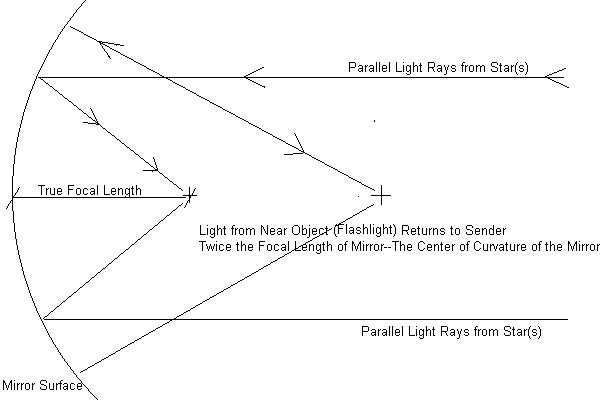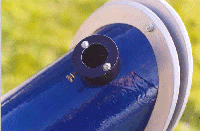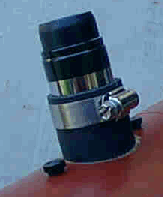Note: Cut the telescope tube the same
length as the focal length of your mirror. Then cut the eyepiece hole back from the front
end of the telescope tube by the radius of the tube. That is, for a 10" diameter
tube, cut the eyepiece hole 5" from the front end; for a 12" diameter tube, cut
the eyepiece hole 6" from the front end. These distances are for mirrors about
1" thick. If you have a thick mirror (i. e. 2"+) the hole should be moved up
toward the front end of the tube an extra 1" to compensate. (i. e., a 12" tube
with a 2" thick mirror would put the hole 5" from the front end; a 10" tube
with a 2" thick mirror would put the hole 4" from the front end.
A more important Note: Now, the above note
ONLY works if you make the homemade focuser AND follow all the details of tailgate
construction, use Sonotube, etc in these plans. If you don't, you will have to do
some simple arithmetic. Folks: it is extremely easy to drill your focuser hole in
the wrong place! Please read the following email and my response:
> I just built a Dob with an 8" f/6 primary mirror,
48" length tube and
> centered the focuser 5" from the end of the tube. I can see the moon really
> clearly, but when I look at distant stars, I can see their light, but in the
> eyepiece, I can only see the primary mirror--the star doesn't come into
> focus. I have a Crayford R&P focuser and a zoom eyepiece (7-20MM).
Hi Daj,
This is a most common problem. I must rewrite that section on the plans!
You did what the plans told you to do; however, you used a commercial focuser, which does
not have as much "in travel" as the homemade one in the plans. You need to
re-position your diagonal closer to the main mirror and re-drill your focuser hole.
Here's how to figure out where EXACTLY:
Number One: Find out the exact focal length of your primary mirror (even if it is supposed
to be 48"--for example--this may vary by an inch or more in either direction). To do
this, the safest way is to bring your primary indoors, prop it up at the end of the hall,
and then, with a piece of paper and a flashlight, start at about TWICE the distance of the
(supposed) focal length, shine the flashlight at the primary and look for a formed image
on the piece of paper (that you are holding in your other hand). IMPORTANT: The flashlight
filament and piece of paper MUST be in the same plane, facing the mirror. Focus the image
on the filament. Mark your floor with a piece of tape, or something. Measure carefully the
distance from the face of your mirror to your mark. DIVIDE BY TWO. This is the focal
length of your mirror. Write it down!

You can, of course, double check this dimension (the True
Focal Length), outside at night, using the Moon or bright Jupiter as a target--don't
forget to bring a friend and a tape measure to help you! And catch the image of Jupiter or
the Moon bouncing back in the same direction!
Now, your telescope, when set up properly, will have a celestial image formed at the field
stop of your eyepiece(s). Look at your eyepiece(s). Specifically, look down the
"wrong end," the open end. Usually you can find a small black ring encircling
the inside of your eyepiece, usually this ring corresponds to where the chrome barrel ends
on the outside of the eyepiece, and where the eyepiece bottoms out when inserting
into focuser. Find it? Now, look into your eyepiece (normally now, through the right end)
and place a pinky finger in the wrong end at the field stop. See how your finger is
magnified? Understand the dynamics of the telescope-to-eyepiece relationship better now? I
am not familiar with zoom eyepieces; do determine where the field stop is--or its average
place in relation to the outside of the eyepiece is, though. What I am trying to say is:
the field stop generally corresponds to where the eyepiece bottoms out in the
focuser, but maybe not in the case of a zoom eyepiece.

Refer to the above diagram, fill in
your own values, if you will:
A + B = your true focal length
C = back of telescope tube to face of mirror
D = back of telescope tube to center of focuser hole
R = radius of tube
Fht + 1" = your focuser height (fully racked in) plus
one inch.
(A and/or D is what we are going to determine).
Okay: it is just simple arithmetic to determine where to drill your focuser hole and place
your diagonal directly below it:
Fht + 1":
Let's say you have a commercial focuser, which, when racked all the way in is 1-5/8"
high (sitting 1-5/8" above the tube). First of all, you do not want your focuser
racked all the way in; you need some "play"; not all eyes focus the same;
not all eyepieces focus the same. Add one inch to this minimalist equation (2-5/8",
in other words). You want the telescopic image to hover 2-5/8" above your tube, in
other words, before being magnified by an eyepiece.
You know all the other factors: The TRUE focal length of your mirror, where the mirror
face is sitting in relation to the back of your tube, and the radius of your tube.
So, as an example, let's say the true focal length of your mirror is 48".
And your mirror face is sitting 2" from the back of your tube (assuming you have
3/4" plywood tailgate + 1/4" masonite collimation pads + a 1" thick mirror
= 2" )
And the radius of your tube is 5".
So: add 5" + 2-5/8" = 7-5/8"
Subtract 7-5/8" from 48" = 40-3/8" This will be the distance from the face
of your mirror to your focuser hole, and the diagonal.
If you add the 2" (the face of mirror to back of tube dimension), you can measure
from the back of the tube 42-3/8"
I drilled my focuser hole in the wrong place on my first homebuilt telescope; it is
simple enough to fix. Did you save the piece you drilled out? Good. you can use
"Bondo" (automotive body filler) to patch it back in--use masking tape to hold
it in until the Bondo sets up (about ten minutes). Simply rotate your tube and redrill
hole--of course you will have to reposition your diagonal, too. Another
way to fix this: Move your mirror cell up or down in the Sonotube--of
course, this will be easier if you keep your tube longer than (you
think) necessary to begin with.
|

 .
.






















































